Last month, the Institute of Public Affairs (IPA) released a report, entitled Mass Immigration Induced Housing Shortage, projecting that Australia will suffer a net housing shortage of 252,800 dwellings by 2028, driven by a projected 1.755 million new net overseas migrants by the financial year ending 2028:
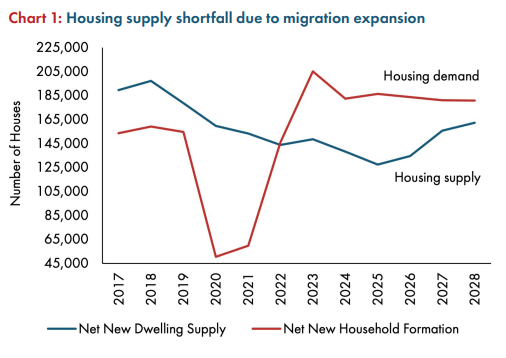
Source: Institute of Public Affairs
This immigration deluge is the equivalent to 117,000 new households formed from immigration alone in search of housing every year, according to the IPA.
This week, the IPA released another report, entitled Australia’s Housing Shortage, which focusses on the impact of international students on Australia’s housing market.
The report contains the below chart showing that Australia’s net student intake hit an all-time high 253,940 in the 2022-23 financial year:

“Between the financial years ending 2025 and 2028, the net annual intake of international students is expected to stabilise to pre-pandemic levels”.
This means that “between the financial years ending 2023 and 2028, we expect 771,012 net new international students to settle in Australia, which will be the equivalent of 308,405 households”:

The next chart shows the impact of the student deluge on Australia’s housing supply:
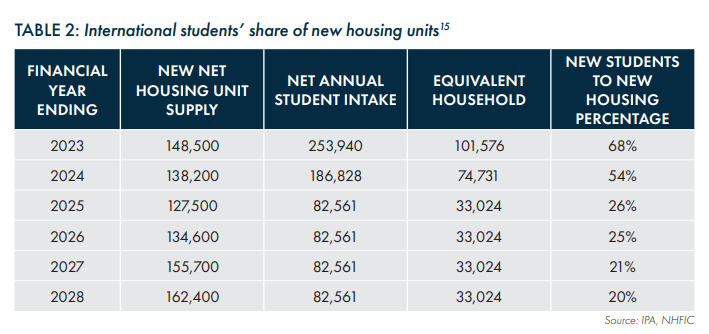
“Housing supply has declined, and is expected to continue to decline, from a high of almost 200,000 units annually, prior to the pandemic, to a low of 127,500 in 2025 before picking up again in a belated response to increased demand”, IPA notes.
The impact will be most severe in Australia’s major capital cities:
“The overwhelming majority of international students (approximately 93%) settle in Australia’s capital cities. According to ABS data, 77% of international student enrolments in the calendar year 2022 occurred in Sydney, Melbourne, and Brisbane”:

IPA estimates that 48% of Australia’s new housing supply in Australia’s capital cities will be consumed by international students:
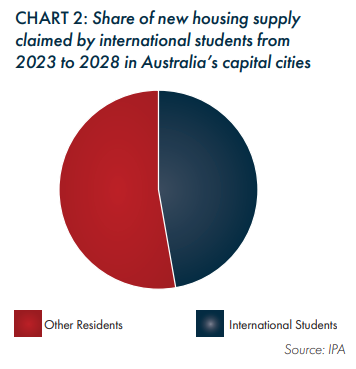
The impact will be most severe in Sydney:
“Approximately 79% of Sydney’s new housing supply will be claimed by international students over the years to 2028… This means that international students are drawing down on the existing stock of dwellings in Sydney, increasing rental prices for Australians and other migrants”:
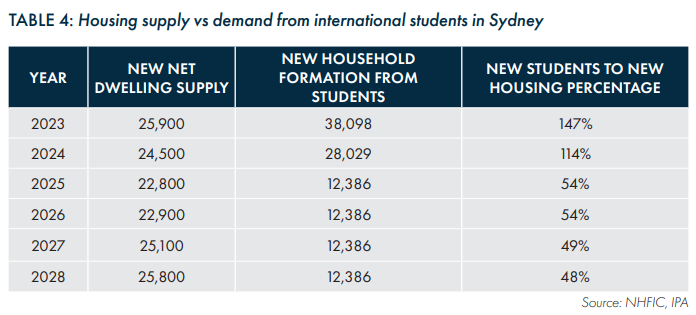
To a lesser extent, Melbourne’s housing market will also be crush-loaded from the international student deluge, with 46% of Melbourne’s new housing supply to be claimed by international students over the years to 2028:
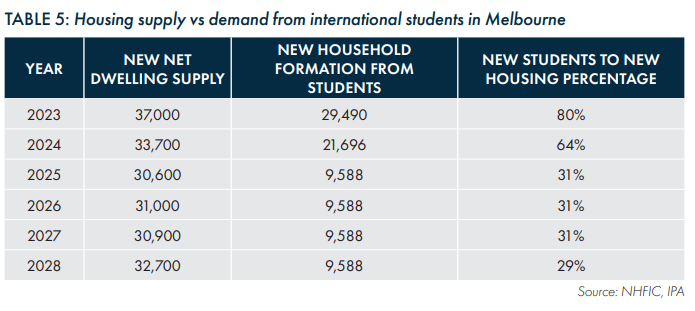
Across the other capitals, the percentage of new housing consumed by international students to 2028 is as follows:
- Brisbane 31%
- Perth 24%
- Adelaide 43%
- Hobart: 46%
- Darwin: 41%
- Canberra: 31%
The report concludes with the following statements:
“Australia is in the midst of a housing crisis: a crisis that has been exacerbated by the unprecedented flow of migrants through Australia’s borders”.
“Approximately two-thirds of the 400,000 net new migrants in the financial year ending 2023 have arrived in Australia on a student visa. Almost two thirds of the subsequent year’s net migration intake will be made up of international students”.
“This IPA research report studies the impact that the current international student intake has and will continue to have on Australia’s housing shortage. The consequences of the unprecedented inflow of international students are not just felt by Australians but also the students themselves, whose educational experience suffers from the housing shortage”.
The entire housing shortage has been engineered by the federal government via its extreme immigration policy.
The former Morrison Government uncapped international student working hours, thereby driving up arrivals of migrants seeking to exploit the student visa system as a backdoor work visa.
The Albanese Government then extended post-study work rights, effectively transforming a student visa into a long-term resident and work visa.
The Albanese Government has also doubled down by opening up new migration pathways, particularly for Indian students.
Australia’s housing shortage could be solved with the stroke of a pen by simply reducing net overseas migration to long-term historical levels of around 100,000 per year.

